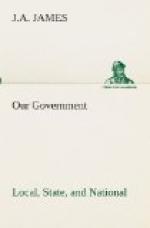[Footnote 30: The total receipts of the Post-office Department for 1910 were $224,128,657.]
As is well known, the Postmaster-General, a member of the President’s Cabinet, is at the head of this department of government. One of the chief burdens of the Post-office Department was formerly the appointment of the so-called fourth-class postmasters, intrusted to the Fourth Assistant Postmaster-General. Executive orders of Presidents Roosevelt and Taft placed 50,000, or about five-sevenths, of these postmasters in the classified service. An order of President Wilson, in 1913, applied the merit system to these offices, by which these postmasters were compelled to demonstrate their fitness for these appointments. This order included all fourth-class postmasters except those paying less than $180 a year. The other three classes, in which are included those postmasters whose salaries are not less than $1000, are appointed by the President, with the consent of the Senate.
Classes of Mail.—Mail matter belongs to one of four classes. In general, the classes and rates are as follows: First class—letters, two cents an ounce; second class—newspapers and periodicals, one cent a pound; third class—books, one cent for two ounces; and fourth class—merchandise, limited to four-pound packages, one cent an ounce.
Free Delivery.—Among the notable advances in the mail service was the provision for the free distribution of mail in the cities of 10,000 inhabitants, or where the annual postal receipts are $10,000 and above.
Rural Free Delivery.—No innovation in postal methods has been more successful than the free delivery of mails in the country districts. The development of the system, since its establishment in 1897, has been remarkable.[31]
[Footnote 31: According to the report of the superintendent for the year ending June 30, 1910, 41,079 routes had been established. The rural population receiving daily mail service amounted to more than 18,000,000. Two thousand one hundred and twenty-four new rural routes were authorized in 1911, aggregating 51,230 miles in length. President Taft urged a further extension of the system.]
Among the good effects resulting from its extensive introduction may be mentioned the following: (1) Correspondence in the communities affected has increased. (2) The circulation of the daily newspaper and of periodical literature has been greatly enlarged, and interest has grown in public affairs. (3) Good roads have been multiplied, for they are made one of the conditions for the introduction of the service. (4) Because the country districts are brought into daily communication with the centres of population, the tendency to quit the farm for the town has been lessened and thus rural free delivery is helping, in some degree, to solve one of the problems of our social and industrial life.




